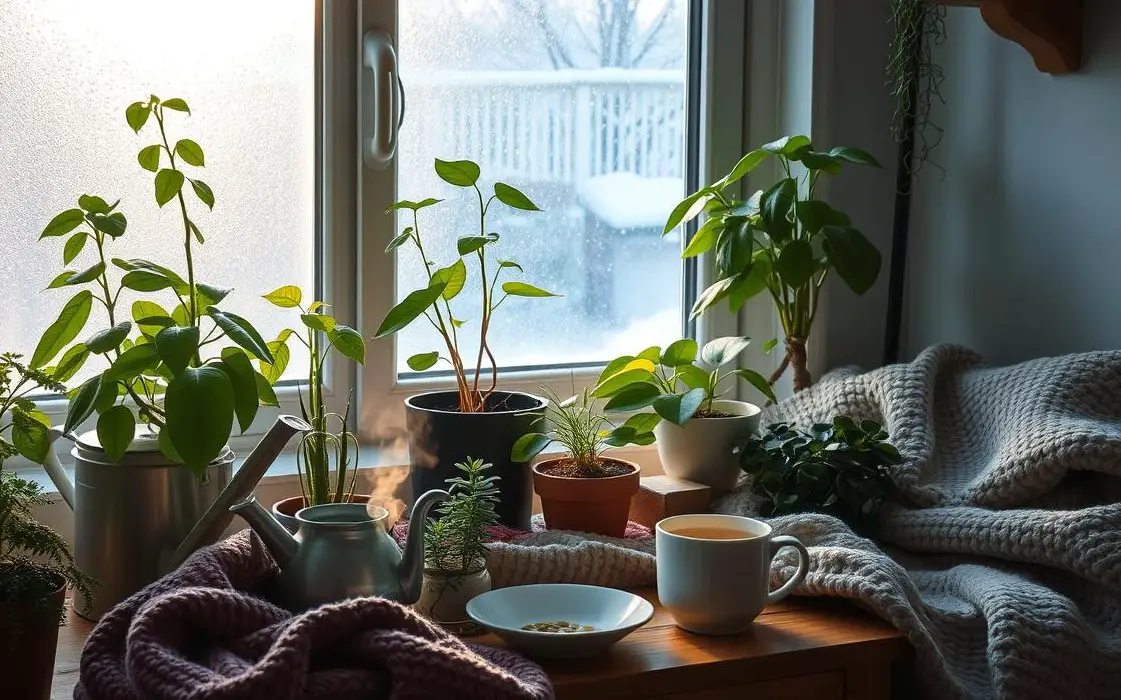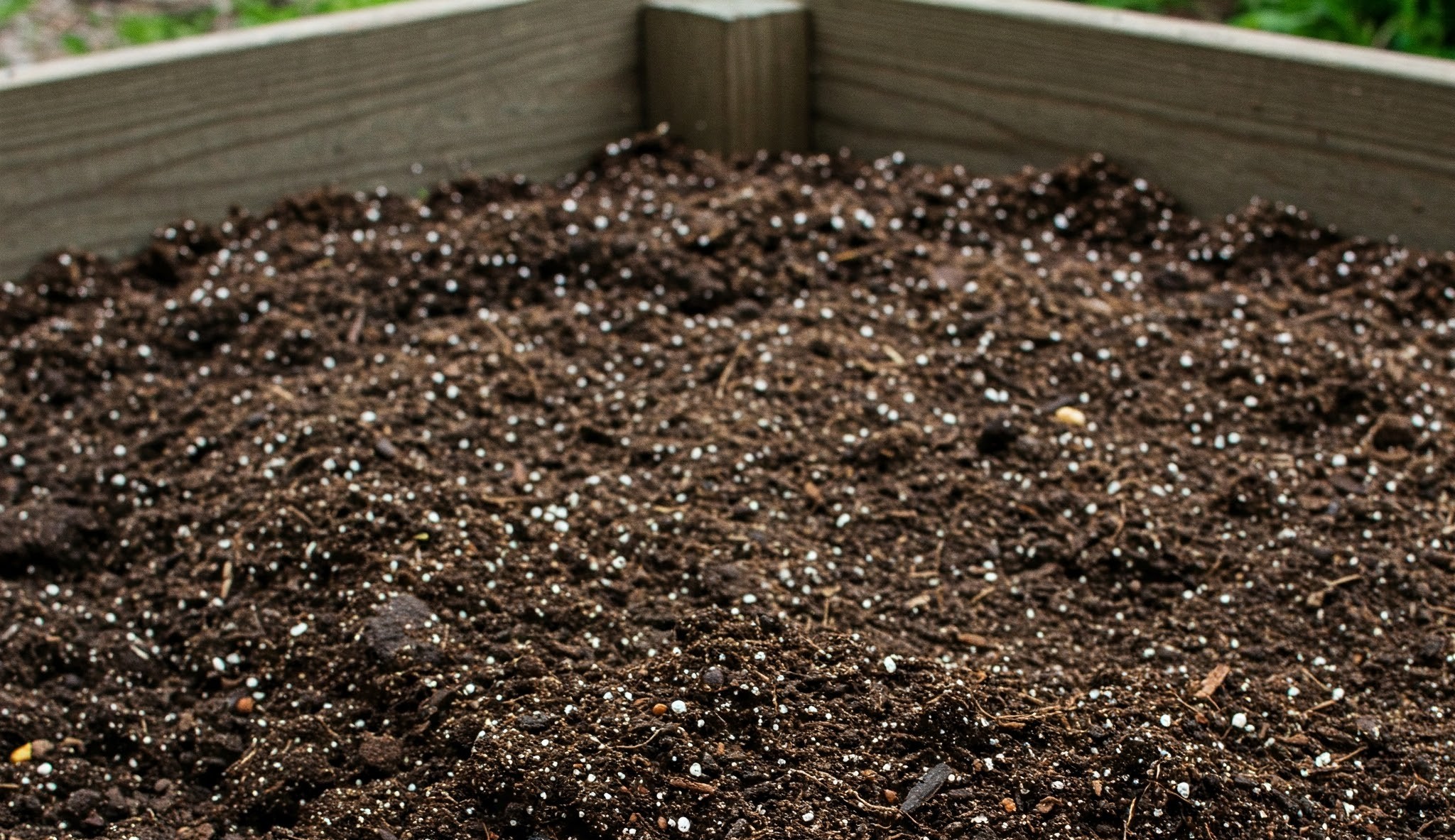How to Take Care of Plants in Winter

With years of experience caring for plants, I’ve learned how important it is to take care of plants in winter to help them stay healthy. During this season, cold weather and shorter days can stress plants, causing slowed growth or dormancy. Indoor plants may struggle with reduced light, leading to yellowing leaves and leaf drop, while outdoor plants are at risk of frost damage to their leaves, stems, and roots.
This guide is designed to share practical tips and proven strategies to take care of plants in winter and ensure they thrive through the colder months.
Understanding Winter’s Impact on Plant Health
Winter can be quite a challenge for our leafy friends. The cold, frost, and shorter days can stress plants out. They can’t quite bundle up in cozy sweaters like we do.
To help your plants brave the winter, it’s important to understand how the cold affects them. The chilly temperatures can slow down their growth, damage roots, and make it tough for them to take up water. Frost can even injure leaves and stems.
But don’t worry! With a bit of love and care, you can help your plants stay strong and healthy all winter long. Whether it’s bringing them indoors, providing extra mulch, or giving them a cozy spot out of the wind, there are plenty of ways to protect your green buddies from the winter chill.
How to care for indoor plants in winter
Winter can be a challenging time for indoor plants. The cold weather, shorter days, and drier air can all take a toll on your green friends. However, with the right care and attention, you can help your plants not only survive but thrive during the winter months. In this guide, we’ll explore essential tips for maintaining the optimal temperature, managing humidity, and ensuring your plants get enough light.
Here are some key tips to keep them healthy and thriving during the colder months:
Temperature
- Daytime Temperature: Keep the temperature between 65-75°F (18-24°C) during the day. This range is comfortable for most indoor plants.
- Nighttime Temperature: At night, let the temperature drop 5-10°F (3-6°C) lower than the daytime temperature. This slight drop mimics natural conditions and helps plants rest.
- Placement: Avoid placing your plants near heating vents or radiators. These spots can get too hot and dry, which can harm your plants.
Humidity
- Use a Humidifier: Winter air can get pretty dry, which isn’t great for plants. A humidifier adds moisture to the air, keeping your plants happy and preventing them from drying out.
- Water and Pebbles Tray: Place your plants on a tray filled with water and pebbles. As the water evaporates, it increases the humidity around the plants. This simple trick helps keep the air around your plants more moist.
- Group Plants Together: When you group plants close to each other, they create a mini-environment that retains humidity better. It’s like a cozy plant party where they all help each other stay moist!
Light
- Grow Lights: Winter days are shorter and often cloudy, which means less natural light for your plants. Grow lights can help by providing the extra light your plants need for photosynthesis and growth. They’re like artificial sunlight that keeps your plants happy even on dark days.
- Low-Light Plants: Place these plants near east- or west-facing windows. These spots get moderate light, which is perfect for plants that don’t need a lot of direct sunlight.
- Medium-Light Plants: These plants can thrive near south-facing windows where they get more light throughout the day. If natural light isn’t enough, you can also use grow lights to make sure they get enough light.
- High-Light Plants: These plants need the most light and do best with direct sunlight. If you don’t have a sunny spot, high-intensity grow lights can provide the strong light they need to stay healthy and grow well.
General Care Tips
- Watering: In winter, plants don’t need as much water. Reduce how often you water them and always check the soil first. If it’s dry a bit below the surface, then it’s time to water. Overwatering can harm your plants.
- Fertilizing: Winter is a slow growth period for most plants. You can cut back on fertilizing until spring. Too much fertilizer can build up in the soil and damage the plant roots.
- Pest Check: Keep an eye out for pests like aphids or spider mites. Inspect your plants regularly and clean the leaves if you see any bugs. It’s easier to manage pests when you catch them early.
- Grouping Plants: Put your plants together in one area. This helps maintain humidity around them, making it easier for them to stay moist and happy. Plus, they look great together!
How to take care of outdoor plants in winter
Winter can be tough on outdoor plants, but with some extra care, you can help them survive and even thrive. Here are some tips:
- Mulching: Apply a thick layer of mulch (like straw, leaves, or wood chips) around the base of your plants. This helps insulate the roots from the cold and reduces temperature fluctuations.
- Watering: Water your plants well before the first hard freeze. Moist soil retains heat better than dry soil. After that, water only when the soil is dry and before a freeze.
- Wrapping and Covering: Use burlap or frost blankets to cover sensitive plants. This provides an extra layer of protection against cold winds and frost.
- Pruning: Avoid heavy pruning in winter as it can make plants more vulnerable to cold damage. Trim only dead or damaged branches.
- Container Plants: If possible, move potted plants to a sheltered area like a garage, shed, or close to the house where they are protected from harsh winds. Group them for added warmth.
- Wind Protection: Erect windbreaks (like fences or hedges) to protect plants from cold, drying winds.
- Winter Care for Specific Plants: Pay attention to the needs of different plants. Some may require more protection than others. For example, evergreen shrubs might need to be wrapped, while perennials might just need mulching.
- Avoiding Salt Damage: Be mindful of salt used to melt ice on driveways and walkways. It can harm plants. Try using sand or kitty litter instead, or create barriers to protect plants from salt spray.
Remember, a little extra effort now can ensure your garden looks beautiful come spring!
Winter Watering Guidelines
Taking care of your plant’s water needs during winter is for their survival and health. Here are some simple guidelines to follow:
- Pre-Winter Watering:
- Water your plants thoroughly before the first hard freeze. Well-hydrated soil retains heat better and protects plant roots.
- Check Soil Moisture:
- Regularly check the moisture level of the soil. Even in winter, plants need water, especially during dry spells.
- Use a moisture meter or stick your finger about an inch into the soil. If it feels dry, it’s time to water.
- Water on Warmer Days:
- Choose warmer days to water your plants. The water has time to soak in before temperatures drop again.
- Avoid watering when the ground is frozen, as water won’t be absorbed and can cause damage.
- Watering Frequency:
- Reduce the frequency of watering compared to the growing season. Most plants require less water in winter due to slower growth.
- Water less often, but make sure to provide enough water each time to moisten the root zone.
- Watering Method:
- Water the soil directly and avoid getting the leaves wet. Wet foliage can lead to frost damage.
- Use a watering can or hose with a gentle spray to avoid disturbing the soil.
- Consider Plant Type:
- Different plants have different water needs. For example, succulents and cacti need very little water in winter, while evergreens may need more regular watering.
- Adjust your watering schedule based on the specific needs of your plants.
Remember, it’s all about finding the right balance to keep your plants happy!
| Plant Type | Watering Frequency | Soil Moisture Level |
|---|---|---|
| Indoor plants | Once a week | Moderately dry |
| Outdoor plants | Once every 10 days | Slightly dry |
Managing Plant Nutrition in Cold Weather
Winter presents unique challenges for plant nutrition, but with careful adjustments, you can keep your plants well-nourished. During this season, it’s best to reduce fertilizer use as plants grow more slowly and need fewer nutrients. Instead, focus on enriching the soil with organic matter like compost, which releases nutrients gradually and helps retain moisture.
Regularly check soil pH to ensure it remains optimal for your plants and adjust as needed. Foliar feeding can be a useful method to address minor nutrient deficiencies, delivering nutrients directly through the leaves. Remember to mulch around your plants to insulate the soil and provide a slow release of nutrients. Be cautious not to overwater, as this can wash away nutrients and harm roots. By observing your plants and adjusting care accordingly, you can support their health and growth even in the colder months.
It’s also important to know the signs of nutrient deficiency. Look out for yellow leaves, stunted growth, and poor fruit production. Recognizing these signs lets gardeners take action to feed their plants right during winter.
| Nutrient Deficiency | Signs and Symptoms |
|---|---|
| Nitrogen | Yellowing leaves, stunted growth |
| Phosphorus | Poor fruit production, weak stems |
| Potassium | Yellowing leaves, scorched edges |
Common Winter Plant Diseases and Prevention
Winter can bring about various plant diseases, primarily due to the cold and damp conditions. Here are some common winter plant diseases and tips on how to prevent them:
1. Powdery Mildew:
- Symptoms: White or gray powdery spots on leaves, stems, and buds.
- Prevention: Ensure good air circulation around plants, avoid overhead watering, and remove any affected plant parts promptly. Use fungicidal sprays if necessary.
2. Root Rot:
- Symptoms: Yellowing leaves, wilting, and decaying roots.
- Prevention: Use well-draining soil, avoid overwatering, and ensure pots have proper drainage. If root rot occurs, trim the affected roots and repot the plant in fresh, sterile soil.
3. Gray Mold (Botrytis):
- Symptoms: Brown or gray fuzzy mold on leaves, stems, flowers, and fruits.
- Prevention: Remove dead or decaying plant material, ensure good air circulation, and avoid overcrowding plants. Fungicidal sprays can also help control the spread.
4. Leaf Spot:
- Symptoms: Small, dark spots on leaves that may grow larger and cause leaves to yellow and drop.
- Prevention: Water plants at the base to avoid wetting leaves, improve air circulation, and remove affected leaves. Fungicidal treatments can be used for severe cases.
5. Snow Mold:
- Symptoms: Circular patches of dead grass with a white, pink, or gray moldy appearance.
- Prevention: Rake leaves and debris from the lawn before winter, avoid excessive nitrogen fertilizer in late fall, and keep the grass mowed to the appropriate height.
6. Rust:
- Symptoms: Orange, red, or brown pustules on the undersides of leaves.
- Prevention: Remove and dispose of affected leaves, provide good air circulation, and avoid wetting the foliage. Fungicidal treatments may be necessary in severe cases.
General Prevention Tips:
- Sanitize Tools: Regularly clean and disinfect gardening tools to prevent the spread of diseases.
- Inspect New Plants: Check new plants for signs of disease before introducing them to your garden.
- Proper Watering: Water plants in the morning to allow excess moisture to evaporate during the day.
- Healthy Soil: Maintain healthy soil with proper pH and nutrient levels to support plant immunity.
Pruning and Maintenance During Winter Months
During winter, it’s important to give your plants a little extra care through pruning and maintenance. Trim away any dead or damaged branches to help your plants stay healthy and focus their energy on new growth. Be careful not to prune too much, as harsh winter weather can stress your plants. Keep an eye out for any pests and clean your plants regularly to prevent infestations. Avoid big temperature changes, and make sure your plants are protected from extreme cold. Grouping your plants can also help maintain humidity and create a cozy environment for them.
Essential Tools and Supplies for Winter Plant Care
Keeping your plants healthy during winter requires a few essential tools and supplies. Here’s a list to help you prepare:
- Grow Lights: Provide extra light for indoor plants when natural sunlight is limited.
- Frost Covers: Protect outdoor plants from frost damage with cloths or specialized frost blankets.
- Mulch: Insulate the soil around outdoor plants to retain warmth and moisture.
- Humidity Tray: Increase humidity for indoor plants by placing them on trays filled with water and pebbles.
- Thermometer: Monitor the temperature around your plants to ensure they stay within a safe range.
- Watering Can with Fine Spout: Helps you control the amount of water given, preventing overwatering.
- Pruning Shears: Trim any damaged or dead parts of the plant to promote healthy growth.
- Plant Humidifier: Adds moisture to the air, especially useful for tropical plants.
Using these tools and supplies can help you maintain a healthy environment for your plants during the winter months.
Special Care Tips for Different Plant Types
Different plants have unique needs, especially during the winter months. Here are some special care tips for various types of plants to ensure they stay healthy and happy:
1. Succulents and Cacti:
- Watering: Water sparingly as they are adapted to dry conditions. Overwatering can cause root rot.
- Light: Place them in bright, indirect light. South-facing windows are ideal.
- Temperature: Keep them in a cool room, but protect them from frost.
2. Tropical Plants:
- Watering: Keep the soil consistently moist but not soggy. Mist the leaves to maintain humidity.
- Light: Provide bright, indirect light. Avoid direct sunlight, which can scorch the leaves.
- Temperature: Maintain warm temperatures (65-75°F / 18-24°C) and avoid drafts.
3. Flowering Plants:
- Watering: Water when the top inch of soil feels dry. Ensure good drainage to prevent root rot.
- Light: Place them in a spot with bright, indirect light. Some flowering plants may need extra light from grow lights.
- Temperature: Keep them in a warm room, avoiding sudden temperature changes.
4. Ferns:
- Watering: Keep the soil consistently moist. They thrive in high humidity, so mist them regularly.
- Light: Provide indirect light. Direct sunlight can burn their delicate fronds.
- Temperature: Maintain moderate temperatures (60-70°F / 16-21°C) and keep them away from drafts.
5. Herbs:
- Watering: Water when the top inch of soil is dry. Avoid waterlogged soil.
- Light: Place them in a sunny spot, like a south-facing window. Use grow lights if natural light is insufficient.
- Temperature: Keep them in a warm room, ensuring they get enough light and warmth to continue growing.
6. Evergreen Shrubs:
- Watering: Water deeply before the ground freezes and during dry spells.
- Light: Ensure they get enough light, but be mindful of winter sunburn.
- Protection: Mulch around the base to protect the roots and consider using burlap to shield them from harsh winds.
FAQ
Can plants stay alive during winter? Yes, plants can stay alive during winter with the right care. By protecting them from extreme cold, providing adequate light, and maintaining proper watering and humidity levels, you can help your plants survive the winter months.
How often should plants be watered in winter? In winter, plants generally need less water. Water them only when the top inch of soil feels dry. Be careful not to overwater, as this can lead to root rot.
Should I mist my plants in winter? Yes, misting your plants in winter can help maintain humidity, especially if the air is dry. This is particularly beneficial for tropical plants and ferns.
Should I cut back my plants for winter? You should prune dead or damaged branches, but avoid heavy pruning in winter. Excessive cutting can stress plants and make them more vulnerable to cold.
How do you keep outdoor potted plants alive in the winter? To keep outdoor potted plants alive, move them to a sheltered area like a garage or porch. Insulate the pots with bubble wrap or burlap, and group them together to create a microclimate.
Why are my plants dying in winter? Plants may die in winter due to overwatering, lack of light, cold drafts, or dry air. Adjust watering, provide supplemental light, and protect them from temperature extremes to help them survive.
Do I need to winterize my plants? Yes, winterizing your plants helps them endure the cold months. This includes mulching, covering sensitive plants, and moving potted plants to protected areas.
Should you cover plants all winter? You don’t need to cover plants all winter, but it’s a good idea to protect sensitive plants during extreme cold spells. Use frost blankets or burlap to shield them from harsh conditions.
How do I prepare my perennials for winter? To prepare perennials for winter, cut back dead foliage, apply a layer of mulch to insulate the roots, and water them well before the ground freezes. This helps protect them from cold and prepares them for regrowth in spring.
Conclusion
Although winter presents challenges for plant care, taking simple yet effective steps ensures their survival and health. Take care of plants in winter by adjusting watering, providing insulation, and managing humidity levels. Whether you are nurturing indoor greenery or safeguarding your outdoor garden, proper care will help your plants thrive until spring.
Recommended Winter Plant Care Products
- Frost Protection Covers – Check on Amazon
- Humidifier for Indoor Plants – Check on Amazon
- Organic Mulch for Insulation – Check on Amazon
- LED Grow Lights – Check on Amazon

I’m John Doe, a Certified Master Gardener with over 20 years of hands-on experience in cultivating healthy and vibrant gardens. My expertise spans organic gardening, soil science, and sustainable pest control. I’ve worked extensively with community gardens and have a deep passion for sharing my knowledge to help others succeed in their gardening endeavors.






